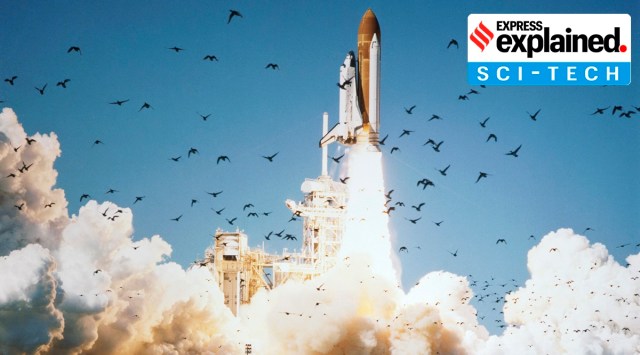Challenger debris recovered: What was the space shuttle disaster and how NASA’s safety rules evolved
Thirty seven years ago, on January 28, 1986, the Challenger spaceship suffered a major malfunction less than 2 minutes into its flight and exploded. What was its mission, and what went wrong? What changed after the disaster?
 This photo shows the space shuttle Challenger lifting off with a crew of seven astronauts in Cape Canaveral, Florida, on Jan. 28, 1986. (Credit: NASA)
This photo shows the space shuttle Challenger lifting off with a crew of seven astronauts in Cape Canaveral, Florida, on Jan. 28, 1986. (Credit: NASA)NASA’s Kennedy Space Center has announced the recovery of debris from the Challenger spaceship that exploded 73 seconds after liftoff killing all seven astronauts aboard 37 years ago.
The US space agency confirmed the recovery months after a TV documentary crew seeking the wreckage of a World War II-era aircraft discovered the artifact off the East coast of Florida in May. Divers found a large man-made object covered partially by sand on the seafloor. Given the location of the object being close to the Florida Space Coast, where the mission was launched from, they contacted NASA.
Following the discovery, NASA Administrator Bill Nelson said: “While it has been nearly 37 years since seven daring and brave explorers lost their lives aboard Challenger, this tragedy will forever be seared in the collective memory of our country. For millions around the globe, myself included, January 28, 1986, still feels like yesterday.” Stressing on the importance of safety of missions, he adds: “This discovery gives us an opportunity to pause once again, to uplift the legacies of the seven pioneers we lost, and to reflect on how this tragedy changed us. At NASA, the core value of safety is – and must forever remain – our top priority, especially as our missions explore more of the cosmos than ever before.”
What was the Challenger space shuttle disaster?
The spacecraft broke apart on January 28, 1986 after it suffered a major malfunction less than 2 minutes into its flight with investigations revealing freezing temperatures having affected the integrity of O-ring seals in the solid rocket booster segment joints. The O-ring seals are used to keep fluids from leaking and components sealed.
The last Challenger mission, dubbed STS-51L, was commanded by Francis R “Dick” Scobee and piloted by Michael J Smith. The other crew members on board were mission specialists Ronald E McNair, Ellison S Onizuka, and Judith A Resnik; payload specialist Gregory B Jarvis; and S Christa McAuliffe, a teacher.
 The space shuttle Challenger explodes shortly after lifting off from Kennedy Space Center, Florida. (AP Photo)
The space shuttle Challenger explodes shortly after lifting off from Kennedy Space Center, Florida. (AP Photo)
The mission was given a go-ahead despite concerns raised by some shuttle program employees. Ice had formed on the shuttle amid freezing temperatures as Challenger remained on the launch pad overnight.
What was the mission?
The shuttle mission, which was NASA’s 25th, was supposed to be a six-day mission wherein, the seven-member crew was to deploy a large communications satellite, deploy and retrieve an astronomy payload to study Halley’s Comet. The teacher, also the first civilian to head to space, was to conduct lessons for schoolchildren from orbit.
The primary objective of the STS-51L mission was to launch the second Tracking and Data Relay System (TDRS) satellite into orbit.
And, what was the Columbia space shuttle accident?
Seventeen years later, in 2003, NASA witnessed another catastrophic disaster after Columbia, which was into its 28th and final flight, got lost during the spacecraft’s re-entry into Earth’s atmosphere on February 1, killing all seven crew members.
On a 16-day mission launched from Kennedy Space Center in Florida on January 16, Columbia conducted a series of international scientific experiments in orbit.
After completing STS-107, the space shuttle disintegrated as it reentered the atmosphere over Texas. STS-107 was the 113th flight of the Space Shuttle program — the fourth human spaceflight program carried out by NASA, which undertook routine transportation for Earth-to-orbit crew and cargo from 1981 to 2011.
India-born Kalpana Chawla and six other astronauts — Rick Husband, William McCool, Michael Anderson, David Brown, Laurel Clark and Ilan Ramon — perished in one of the worst US space mishaps.
 From left to right: David Brown, Rick Husband, Laurel Clark, Kalpana Chawla, Michael Anderson, William McCool, Ilan Ramon. (Credit: NASA)
From left to right: David Brown, Rick Husband, Laurel Clark, Kalpana Chawla, Michael Anderson, William McCool, Ilan Ramon. (Credit: NASA)
Investigations pointed towards a piece of foam that broke off during launch and damaged the thermal protection system on the leading edge of the orbiter’s left wing. During re-entry the damaged wing slowly overheated and came apart, eventually leading to loss of control and disintegration of the vehicle.
According to a NASA report on the tragedy, the crew had just 41 seconds of consciousness to respond to the impending disaster. The report said the astronauts were unaware that their re-entry was compromised. Although they performed courageously to find their way to safety, NASA’s Spacecraft Crew Survival Investigative Team had said the accident was “not survivable”.
What changed after Challenger and Columbia disasters?
Space Shuttle flight operations were suspended for more than two years after both the disasters.
NASA’s safety concerns changed as the space agency created an Office of Safety and Mission Assurance, developed new risk assessment procedures, and established an environment in which everyone can raise safety concerns. The agency also created the Apollo Challenger Columbia Lessons Learned Program to share these lessons within the agency and with other government, public, commercial, and international audiences.
What will NASA do with recovered debris of Challenger?
According to the agency website, NASA is considering what additional actions it may take regarding the artifact that will properly honour the legacy of the fallen astronauts and their families.
- 01
- 02
- 03
- 04
- 05






































